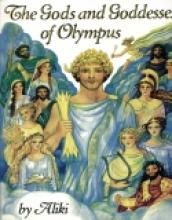Ancient Greece Mythology
The Genealogy of Greek Mythology
Subject(s):
Setting:
Grade / Age level:
Review:
Additional notes:
double-sided fold-out chart with slipcase - over 17 feet long!
Donated for review by Penguin-Putnam
Reviewed by:
First reviewed:
3-17-04
The Gods and Goddesses of Olympus
Subject(s):
Setting:
Grade / Age level:
Review:
This 48-page picture book is designed to introduce early-elementary-aged children to the myths of Ancient Greece through text and pictures. We have several books in our family library by Aliki, and I was prepared to enjoy this one just as much. However, I was disappointed in both the artwork and the presentation of the myths.
The first pictures in the book are somewhat dark and eerie, and I would hesitate to show them to a young child. As the book progresses, the pictures take on more form and color, but they are rather intense. There are some very upsetting pictures of babies being eaten and subsequently brought back up, as well as evil, violent scenes that would be shocking to all but the most worldly child. I also disliked the many pictures with almost-total nudity and women clad in transparent clothing.
There are many, many versions of the most familiar Greek myths, and some are more suitable to children than others. These very brief retellings of the myths focus on the adult aspects of the relationships between the various gods and goddesses, to the exclusion of details that are more appropriate for the attention of a child. The author also makes the point that (p.48): "Even today, the gods are valued for their human qualities, their humor, their lessons, and their wisdom." This is simply untrue in our Catholic home; interesting, perhaps, but not "valued". This book is not recommended.
The first pictures in the book are somewhat dark and eerie, and I would hesitate to show them to a young child. As the book progresses, the pictures take on more form and color, but they are rather intense. There are some very upsetting pictures of babies being eaten and subsequently brought back up, as well as evil, violent scenes that would be shocking to all but the most worldly child. I also disliked the many pictures with almost-total nudity and women clad in transparent clothing.
There are many, many versions of the most familiar Greek myths, and some are more suitable to children than others. These very brief retellings of the myths focus on the adult aspects of the relationships between the various gods and goddesses, to the exclusion of details that are more appropriate for the attention of a child. The author also makes the point that (p.48): "Even today, the gods are valued for their human qualities, their humor, their lessons, and their wisdom." This is simply untrue in our Catholic home; interesting, perhaps, but not "valued". This book is not recommended.
Reviewed by:
First reviewed:
4-19-01



